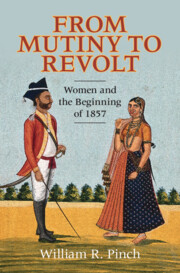
-
Select format
-
- Publisher:
- Cambridge University Press
- ISBN:
- 9781139029971
- 9780521885317
- 9781009682428
- Dimensions:
- (229 x 152 mm)
- Weight & Pages:
- 00kg, 228 Pages
- Dimensions:
- (229 x 152 mm)
- Weight & Pages:
- 0.25kg, 228 Pages
You may already have access via personal or institutional login
Book description
Why did the nonviolent Meerut mutiny of 1857 in India explode into a violent military revolt? Breaking new ground on the events of May 10, William Pinch reexamines the evidence, shifting our focus toward the identity of female participants and their actions in the hours before the revolt began. Drawing upon a wide range of sources, including Hindi folksongs, military records, police reports, literary fiction, and Urdu memoir, he creates snapshots from the perspective of key figures to uncover the social and emotional world of the military 'cantonment' and its rural hinterland. By foregrounding the lives of ordinary 'military women' and 'their men' - the Indian sepoys who peopled the revolt - Pinch challenges conventional narratives and guides readers through the literary and historiographical echoes of the fateful decision to take up arms against the British.
Reviews
‘A refreshing retelling of the 1857 revolt that puts the micro-optic on the cantonment town of Meerut to call out hitherto unheard tales of women, prostitutes, Sepoys and ordinary people. A brilliant narrative that both thrills and informs.'
Seema Alavi - Ashoka University
‘This gripping revisionist narrative of 1857 proves that behind every mutinous sepoy there was a world of women doing the unsung work of anti-colonialism. Drawing on facts and fictions, Pinch brings them out of the shadows of the sadr bazaar and into imperial history for good.'
Antoinette Burton - University of Illinois Urbana-Champaign
‘The bazaar at Meerut, a liminal space wherein mingled British and Indian bodies and practices, is deftly explored by William Pinch in this richly textured microhistory that provides insights into what transformed mutinying sepoys into rebels in 1857 and illuminates the critical role played by the women of the cantonment.'
Douglas M. Peers - University of Waterloo
‘This brilliant microhistory of why soldiers in Meerut revolted in 1857 offers a riveting narrative that is centered atypically on marginalized women. It is an innovative take on the cataclysmic revolt of 1857 and a perspicacious meditation on the writing of history itself. An absolute must read!'
Mrinalini Sinha - University of Michigan
‘Pinch's book is a tour de force, a brilliant reframing of the story of the Revolt of 1857. In this microhistorical tome, Pinch draws out the social and emotional world of the pre-mutiny Meerut cantonment and the heretofore ignored incendiary role that women – female relatives, wives, concubines, mistresses and prostitutes (tawaifs) - played in the mutiny. The book's engaging narrative interweaves military history with histories of emotions, gender, fictive histories and literary fiction to advance a novel way of thinking about history as ontology.'
Aparna Vaidik - Ashoka University
Contents
Metrics
Full text views
Full text views help Loading metrics...
Loading metrics...
* Views captured on Cambridge Core between #date#. This data will be updated every 24 hours.
Usage data cannot currently be displayed.
Accessibility standard: Missing or limited accessibility features
Why this information is here
This section outlines the accessibility features of this content - including support for screen readers, full keyboard navigation and high-contrast display options. This may not be relevant for you.
Accessibility Information
The PDF of this book is known to have missing or limited accessibility features. We may be reviewing its accessibility for future improvement, but final compliance is not yet assured and may be subject to legal exceptions. If you have any questions, please contact accessibility@cambridge.org.
Content Navigation
Table of contents navigation
Allows you to navigate directly to chapters, sections, or non‐text items through a linked table of contents, reducing the need for extensive scrolling.
Index navigation
Provides an interactive index, letting you go straight to where a term or subject appears in the text without manual searching.
Reading Order and Textual Equivalents
Single logical reading order
You will encounter all content (including footnotes, captions, etc.) in a clear, sequential flow, making it easier to follow with assistive tools like screen readers.
Visualised data also available as non‐graphical data
You can access graphs or charts in a text or tabular format, so you are not excluded if you cannot process visual displays.
Visual Accessibility
Use of colour is not sole means of conveying information
You will still understand key ideas or prompts without relying solely on colour, which is especially helpful if you have colour vision deficiencies.
Use of high contrast between text and background colour
You benefit from high‐contrast text, which improves legibility if you have low vision or if you are reading in less‐than‐ideal lighting conditions.

